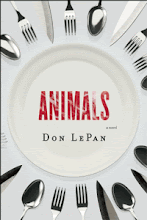I still have not read the Harry Harrison novel Make Room! Make Room! on which Soylent Green is based, but I did finally get around recently to seeing the Richard Fleischer film starring Charlton Heston. From one angle Soylent Green is indeed similar to Animals—like Animals (and, of course, like Swift’s “A Modest Proposal”) it has at its center the idea of humans eating other humans. But it is a work with a message that points in an entirely different direction. Both Soylent Green and Animals are dystopias depicting worlds in which resources have been depleted and there is widespread poverty. But in the world of Soylent Green the root cause of the trouble is overpopulation. The population of New York alone has ballooned to 40 million, farmland has been paved over, food is scarce. Everyone relies on rations produced by the Soylent Corporation—Soylent Red and Soylent Yellow, produced from vegetable extracts, and the high-protein Soylent Green—said to be produced from plankton. Then comes the revelation: it’s not from plankton at all. “Soon they’ll be breeding us like cattle. You’ve got to warn everyone and tell them. Soylent Green is people! We’ve got to stop them somehow!” is the memorable cry of Robert Thorn (the Charlton Heston character) at the movie’s end. The horror at the heart of Soylent Green, then, is not that animals raised for food are treated with terrible cruelty; it is that we might contemplate treating humans as we do other animals. The crucial scene in the movie is one in which the elderly Sol Roth (played by Edward G. Robinson) has been persuaded to make room for others by allowing his life to come to an end. The horror is that his flesh will be converted into protein rich Soylent Green after his death. Appalling though that is, the horror begins and ends there, with no analogy drawn to the ongoing horrors factory farming imposes on living animals--horrors that were becoming the norm in America just as the film was being made. (Far from being treated cruelly as he prepares for death, indeed, Roth is thoroughly pampered.) Soylent Green, in other words, does not ask us to care how cattle are treated (let alone wonder if we should be killing them); its message is simply watch out, lest we start treating each other as we do cattle.
Is that such a bad message to convey? Or was it in 1973? As it turned out, yes, though it need not have been. Had people reacted to the scare-mongering about overpopulation in part by cutting down drastically on their consumption of meat and dairy products (as Frances Moore Lappé advised in her 1971 Diet for a Small Planet), it would have been a very good thing indeed. But few reacted in that way. The important response came not from any change in individual behavior, but from scientists and from industry. Famously, Norman Borlaug and others led a “green revolution” that greatly increased crop yields. Even that, it is now argued, may have been far from an unmitigated good. But the great evil came in the corresponding increase in yields in meat production. Here is O.E. Kolari of the American Meat Institute:
The doubling of the population in such a short span of time will tax the world's resources. ... The ability of American agriculture to supply adequate food, and in our particular area, meat, to needy peoples of the world, can be seriously questioned. ... The most serious food shortage in the future will be protein of high quality, and here is where the meat industry becomes important. … Meat production is steadily increasing in the United States, and improvements in meat production in the United States and other parts of the world suggest an adequate meat supply in the years ahead, although a doubling of meat production within the next 15-20 years may be required. ... It can be calculated that an increase in the efficiency of production may be expected to reduce production costs and, therefore, also selling price by as much as 20%. ... Changes in the development of new products, new facilities, and other developments in the meat industry may not be as rapid as one would like to see ... but changes are occurring, and change is the hallmark of progress. (O.E. Kolari, "The Use of Animal Protein for Food," in Journal of Animal Science, 1966, 25, pp 567, 569, 571)
That may sound largely benign, but as Kolari and others called for further “improvements” of the sort that had already begun in the American meat industry, the practical effect was again and again to ratchet up the cruelty, all in the name of greater yield, of "efficiency," of “improvement,” in a process that continues to this day. They were ahead of the doomsayers; Kolari’s article was published in 1966, two years before Paul Ehrlich’s The Population Bomb, seven years before Soylent Green. But one practical effect of the population doomsayers of the 1960s and the 1970s was to foster an unquestioning acceptance of “improvements” that were already underway in the meat and dairy industries—and an abiding reluctance among most of us to know how those “improvements” are usually achieved. The implicit assumption may have been unstated, but it is not hard to discern: if greater "efficiency" in the meat industry was necessary to stave off some of the horrors that would otherwise result from human overpopulation, well, that was a price non-human animals would have to pay. Soylent Green today is a film that's hard to take seriously--it's entertaining in all sorts of ways it probably didn't mean to be. But to the extent that it had serious effects in its day, it's hard to imagine that they were for the good.





No comments:
Post a Comment
Comments welcome!